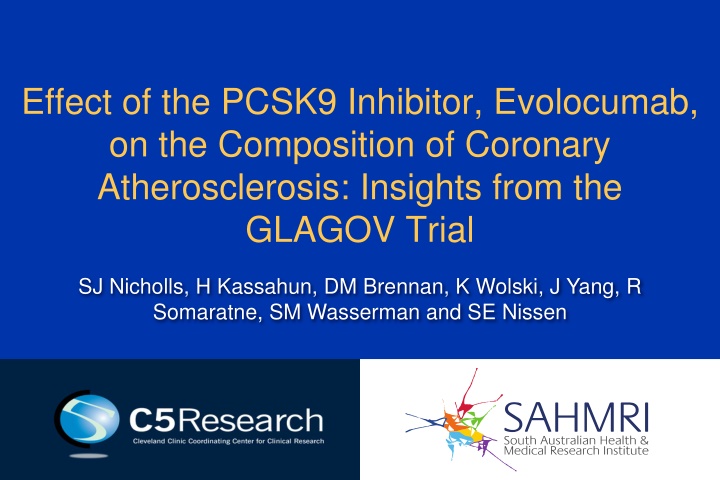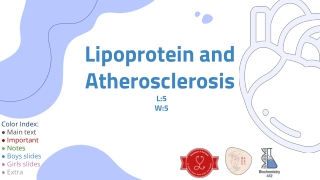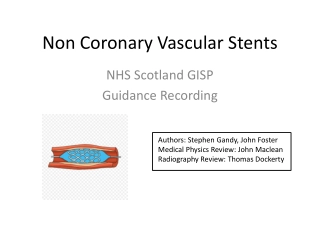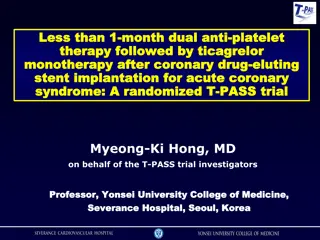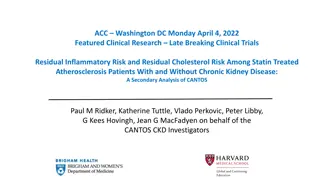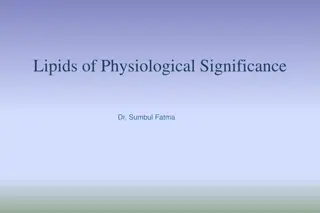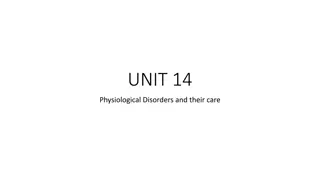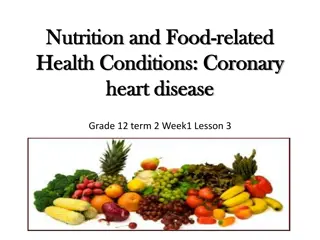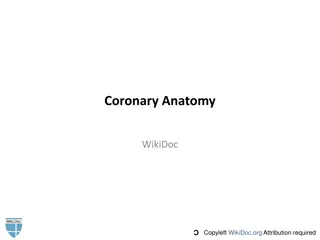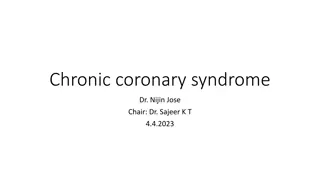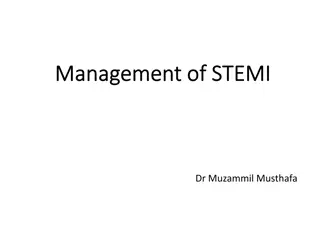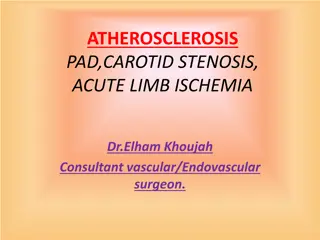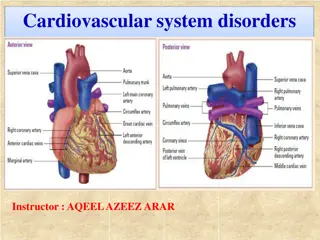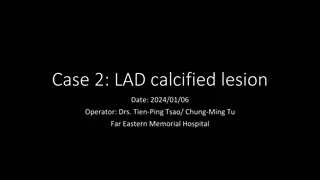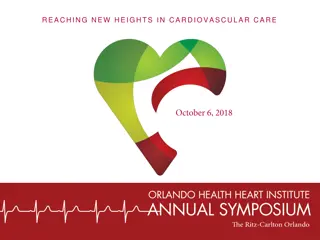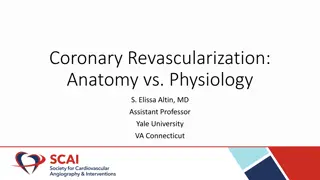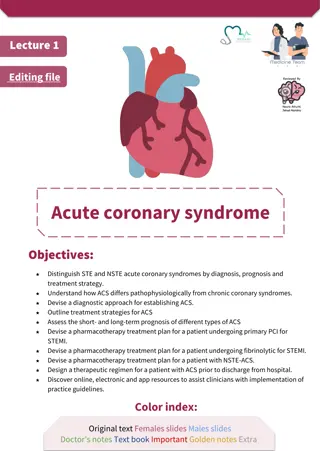Effect of Evolocumab on Coronary Atherosclerosis Composition: Insights from GLAGOV Trial
This study delves into the impact of PCSK9 inhibitor Evolocumab on the composition of coronary atherosclerosis, offering valuable insights based on findings from the GLAGOV Trial. The research, conducted by an esteemed group of authors, sheds light on the potential effects of Evolocumab on coronary artery disease progression and highlights significant contributions to the field of cardiology.
Download Presentation

Please find below an Image/Link to download the presentation.
The content on the website is provided AS IS for your information and personal use only. It may not be sold, licensed, or shared on other websites without obtaining consent from the author.If you encounter any issues during the download, it is possible that the publisher has removed the file from their server.
You are allowed to download the files provided on this website for personal or commercial use, subject to the condition that they are used lawfully. All files are the property of their respective owners.
The content on the website is provided AS IS for your information and personal use only. It may not be sold, licensed, or shared on other websites without obtaining consent from the author.
E N D
Presentation Transcript
Effect of the PCSK9 Inhibitor, Evolocumab, on the Composition of Coronary Atherosclerosis: Insights from the GLAGOV Trial SJ Nicholls, H Kassahun, DM Brennan, K Wolski, J Yang, R Somaratne, SM Wasserman and SE Nissen
Disclosures Research support: AstraZeneca, Amgen, Anthera, Eli Lilly, Esperion, Novartis, Cerenis, The Medicines Company, Resverlogix, InfraReDx, Roche, Sanofi- Regeneron and LipoScience Consulting and honoraria: AstraZeneca, Eli Lilly, Anthera, Omthera, Merck, Takeda, Resverlogix, Sanofi-Regeneron, CSL Behring, Esperion, Boehringer Ingelheim
Background The PCSK9 inhibitor, evolocumab, lowers LDL-C, induces plaque regression on IVUS and reduces CV events in statin-treated ASCVD patients The impact of PCSK9 inhibition on the composition of coronary atheroma has not been investigated. Virtual histology is an experimental technique which characterizes plaque composition and may have utility in assessing effects of anti-atherosclerotic therapies.
GLAGOV Trial Schematic 968 patients with angiographic CAD, stable statin dose and LDL-C 80 mg/dL OR 60-80 mg/dL and 1 major or 3 minor risk factors Screening, placebo run-in period End of Study IVUS Placebo SC monthly Randomization Up to 4 week lipid stabilization period Coronary Angiogram Evolocumab 420 mg SC monthly Baseline IVUS 2-4 weeks Max. 6 weeks 12 0 70 76 24 36 Week 4 80 52 64
GLAGOV VH Substudy Determine if evolocumab produced changes in VH- derived plaque components (dense calcium, fibrous, fibrofatty, necrotic core) compared with placebo in 331 patients with evaluable VH imaging. The prespecified statistical plan sought to compare changes in volumetric measures, adjusting for baseline values and multiple comparisons. The primary endpoint was the absolute change in dense calcium volume from baseline to week 78.
Baseline Demographics and Statin Usage Characteristic Placebo (n=167) Evolocumab (n=164) Age 59.7 59.3 Male Gender 76.0% 70.7% BMI (kg/m2) 29.5 29.7 Diabetes 16.2% 18.9% Smoking 22.2% 29.9% Baseline statin use 99.4% 98.8% High intensity 57.5% 59.8% Moderate intensity 41.3% 37.8% Baseline LDL-C (mg/dL) 92.0 90.9 Baseline CRP (mg/L) 1.5 1.7
Percent Change in Biochemical Parameters Characteristic Placebo (n=167) Evolocumab (n=164) P Value LDL Cholesterol +0.6% -62.8%*** <0.0001 HDL Cholesterol +7.5%*** +11.6%*** 0.02 Triglycerides +2.7%* -11.5%** 0.0002 CRP -21.4% -6.7%** 0.11 Lp(a) -2.5% -22.7%*** <0.0001 * P<0.05, ** P<0.01 and *** P<0.0001 compared with baseline
Change in Measures of Plaque Burden Placebo (n=167) Evolocumab (n=164) Characteristic P Value PAV (%) +0.17 -1.20* <0.0001 TAV (mm3) -0.8 -3.6* 0.04 PAV regressors (%) 46.1 68.3 <0.0001 TAV regressors (%) 53.3 64.6 0.04 PAV: percent atheroma volume; TAV: total atheroma volume. * P<0.0001 compared with baseline
Primary Endpoint: Change in Normalized Dense Calcium Volume Change calcium volume (mm3) Statin Monotherapy * P<0.05 and ** P<0.001 compared with baseline (exploratory analysis). *** Hochberg adjusted p value 1.5 1.0** 1.0 0.6* 0.5 P=0.49*** 0.0 Statin + Evolocumab
Secondary Endpoint: Change in Volume of Other VH Parameters Statin Monotherapy Statin + Evolocumab 0 -0.1 Change Volume (mm3) -0.6 P=0.49*** -2 P=0.49*** P=0.49*** -2.4** -4 -3.0** -3.0* -6 -5.0** -8 Fibrofatty Fibrous Necrotic Core * P<0.01 and ** P<0.001 compared with baseline (exploratory analysis). *** Hochberg adjusted p value
Secondary Endpoint: Absolute Change in VH-Derived Percentage Plaque Measures P Characteristic Placebo (n=167) Evolocumab (n=164) Value** +1.0 0.4* +2.2 0.4* Dense calcium (%) 0.10 -0.9 1.1 -1.6 1.1 Fibrofatty (%) 0.67 -0.6 0.8 -1.4 0.8 Fibrous (%) 0.67 +0.4 0.5 +0.9 0.6 Necrotic core (%) 0.67 * P<0.01 compared with baseline (exploratory analysis) **Hochberg adjusted
Correlation Between Change in VH Measures and Biochemical Parameters Characteristic Change LDL-C Change CRP Dense calcium r = -0.15 r = 0.07 Fibrofatty r = 0.03 r = -0.04 Fibrous r = 0.06 r = -0.01 Necrotic core r = -0.01 r = 0.07
Exploratory Analysis: Change in VH-Derived Plaque Measures and Regression Tertiles of Change PAV (%) Characteristic P Value <-1.57 -1.57 0.57 >0.57 0.5 0.3 0.9 0.3** 1.0 0.3** Dense calcium (mm3) 0.65 -6.3 1.2** -3.7 1.2** -2.0 1.2 Fibrofatty (mm3) 0.03 -6.3 0.7** -2.3 0.7** 0.5 0.8 Fibrous (mm3) <0.001 -2.6 0.6** 0.1 0.6 1.3 0.6* Necrotic core (mm3) <0.001 * P<0.05 and ** P<0.01 compared with baseline
Exploratory Analysis: Baseline LDL-C <70 mg/dL Characteristic Placebo (n=26) Evolocumab (n=35) P Value +0.4 0.8 -0.3 1.7 Dense calcium (mm3) 0.54 -6.0 3.1 -6.7 2.6** Fibrofatty (mm3) 0.87 -0.8 2.0 -3.4 1.7* Fibrous (mm3) 0.32 +0.4 1.4 -2.9 1.2* Necrotic core (mm3) 0.08 * P<0.05 and ** P<0.01 compared with baseline
Conclusion Evolocumab on a background of optimal statin therapy produced robust lowering of LDL cholesterol and plaque regression by conventional IVUS. However, VH imaging failed to detect any difference between treatment groups for individual plaque components. These findings further fuel uncertainty regarding the utility of VH imaging in drug development to assess the effect of anti-atherosclerotic therapies.
Final Thoughts The inverse correlation between changes in LDL cholesterol and plaque calcium supports prior reports in studies of high intensity statins. While the underlying mechanism remains uncertain, it questions the use of serial calcium scoring to monitor responses to lipid lowering interventions. VH yields predictable, but not incremental information, in the setting of plaque regression. It will be of interest to see if other modalities can provide better insights.
